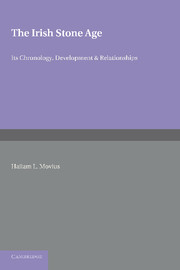Book contents
- Frontmatter
- Dedication
- Contents
- ILLUSTRATIONS
- FOREWORD
- PREFACE
- INTRODUCTION
- Part One THE CHRONOLOGY OF THE LATE-GLACIAL AND EARLY POST-GLACIAL PERIODS IN NORTHERN AND WESTERN EUROPE
- Part Two THE STONE AGE CULTURES OF IRELAND
- CHAPTER I The Antiquity of Man in Ireland
- CHAPTER II The Mesolithic Culture of the Irish Raised Beaches
- CHAPTER III The Origin and Affinities of the Larnian Culture
- CHAPTER IV Post-Larnian Developments
- CHAPTER V Conclusions
- Appendices I-VI
- REFERENCES CITED IN THE TEXT
- CLASSIFIED LIST OF REFERENCES TO CAVE RESEARCH AND STONE AGE ARCHAEOLOGY IN IRELAND
- ADDENDUM
- INDEX
CHAPTER I - The Antiquity of Man in Ireland
from Part Two - THE STONE AGE CULTURES OF IRELAND
Published online by Cambridge University Press: 05 June 2016
- Frontmatter
- Dedication
- Contents
- ILLUSTRATIONS
- FOREWORD
- PREFACE
- INTRODUCTION
- Part One THE CHRONOLOGY OF THE LATE-GLACIAL AND EARLY POST-GLACIAL PERIODS IN NORTHERN AND WESTERN EUROPE
- Part Two THE STONE AGE CULTURES OF IRELAND
- CHAPTER I The Antiquity of Man in Ireland
- CHAPTER II The Mesolithic Culture of the Irish Raised Beaches
- CHAPTER III The Origin and Affinities of the Larnian Culture
- CHAPTER IV Post-Larnian Developments
- CHAPTER V Conclusions
- Appendices I-VI
- REFERENCES CITED IN THE TEXT
- CLASSIFIED LIST OF REFERENCES TO CAVE RESEARCH AND STONE AGE ARCHAEOLOGY IN IRELAND
- ADDENDUM
- INDEX
Summary
GENERAL ASPECTS AND NATURE OF THE PROBLEM
The final disappearance of the last ice-sheet, at about the beginning of the seventh millennium B.C., appears to represent the earliest date for the settlement of Ireland on the basis of existing data. Although the evidence from Inchnadamff, discussed on pp. 71—73, demonstrates that Scotland was already occupied by wandering groups of hunters at the very end of the Late-Glacial Period, there is no proof that man immigrated to Ireland until Early Post-Glacial times. During the Boreal Period a partial land-bridge across the Irish Sea (see pp. 87—89) made possible the dispersal of new forest forms from the Continent via Britain, as well as a temperate fauna and man, but up to the present no clear association of human remains or artifacts with glacial deposits has been established in Ireland. However, various claims have been made for the existence of an Irish Palaeolithic; these have been based on wholly unreliable data. In several cases the typological convergence of certain large coarse Mesolithic implements upon some of the established Lower Palaeolithic forms has led to confusion in this regard, whereas in other cases the claims have resulted from a misinterpretation of the facts. The material published by the Reverend Frederick Smith (1909, pp. 308—32) from Killiney Bay, County Dublin, is a good example of a claim in the latter category. In the first place, all of the illustrated specimens appear to be natural—it is only necessary to look over the examples of so-called Lower Palaeolithic implements shown by the Reverend Mr Smith from Northern Britain and Scotland to be convinced of this point. Not even the most ardent supporters of Palaeolithic man in Ireland have considered the Killiney series. Nor has the material from the Arctic beds at Ballyrudder, near Larne, County Antrim (see p. 37), ever been accepted as human, although Knowles (1892) submitted a series from this locality as evidence of an interglacial occupation of Ireland.
In the second category, the claims concern certain crude, very heavily rolled, coarse implements, which are Mesolithic in age, although to some degree reminiscent of certain Lower Palaeolithic types. In some cases they display surface scratches which resemble glacial striae, but which are a result of severe wave action.
- Type
- Chapter
- Information
- The Irish Stone AgeIts Chronology, Development and Relationships, pp. 105 - 120Publisher: Cambridge University PressPrint publication year: 2013



